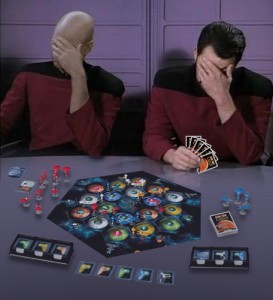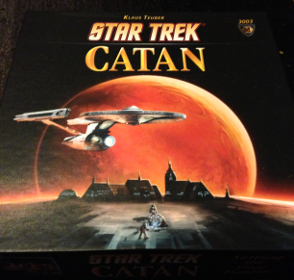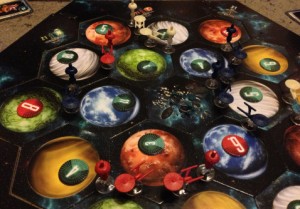Friday Night Unplugged #3: Star Trek: Catan
- Updated: 23rd Nov, 2012
It’s Catan Jim but not as we know it.
In this week’s edition of Friday Night Unplugged we’re activating our warp drives and engaging the cheesy puns while checking out the latest edition of The Settlers of Catan.
Designed by Klaus Teuber and published by Mayfair the original Catan has been a favourite of families since its initial release way back in 1995. With a heavy economical theme, Catan spearheaded the rise of similar “eurogames” usually released by German publishers. Since then it’s had a horde of expansions, multiple re-prints and even a few adjustments in the form of The Settlers of Catan: Junior Edition and The Settlers of Catan: Family Edition. Star Trek: Catan is more than just a tweak, more than an expansion. It’s a full retheme set in the world of the original series of Star Trek, but does this work in its favour?
The Basics
The aim of Star Trek: Catan is simple: you start with a few outposts and starships granted to you by the Federation from there you must expand your supply chains and build new outposts. Resources can be gained from planets, traded with the bank (with a 4:1 ratio) or with outposts attached to trade hubs (2:1 for the resource specific to that hub). Players must also be wary of each other; with only so many planets to gather resources from it’s a race to settle the best first.
In basic Catan, the board is made of a set of hexagonal tiles each with one of 5 land types. In Star Trek, the land has been replaced with planets and the resources have been themed to the core items needed for space based survival.
Players can start with one of the pre-defined board layouts or create their own with the advanced setup. All players also start with 2 outposts and 2 starships on the board, either on pre-set positions or advanced placement rules. Each player also starts with a character card from the original crew, each with unique abilities, after use they can be flipped for use again or swapped for a different card. Turn order is simple and goes as follows.
- The active player rolls 2 dice. Each outpost directly on a corner of that numbered tile gain the resource shown by the planets colour. Green is for dilithium, red for tritanium, blue for water, white for oxygen and yellow for food.
- Rolling a 7 moves the Klingon Battlecruiser out of the asteroid belt and onto a planet of your choice. Resources can’t be gained from planets with the Battlecruiser
- The player can then discard cards to build new structures. Starships, outposts and habitat rings can be built or players can trade resources for a (usually) helpful development card.
- When the first player reaches 10 Victory Points, gained by placing outposts, drawing VP development cards or building the largest fleet of ships the game ends.
Time to play.
For sake of ease we followed the basic setup in the instruction manual. This just means that outposts and ships start on specific points on the board and the resource tiles are in pre-defined spots on the board. As usual I was joined again by Fi and Josh who chose the Red and White player colours respectively leaving me as Blue. The early game went smoothly enough; Fi and I were lucky enough to roll for the resources we needed, however Josh had no such luck. We started to head out in search of more frequently rolled resources with our respective Starfleets already dividing the board.
After a shortage of useful resource rolls and multiple occasions of us passing play, things turned around again. I sped ahead by building more outposts and gaining the Longest Supply Route for having a route with 5 star ships bringing me to a total 7 VP. My assured lead didn’t last long though. With Josh still flagging behind and Fi pulling some lucky Development cards she quickly joined 2 of her routes together, stealing the Longest Supply Route card and bordering off a large chunk of the board. We were now running head to head.
The lategame suffered from the same problem we had earlier in the game. Despite tactically placing our outposts to gain the most from commonly rolled and useful resources we had no luck with the dice. After a long period of gathering uneeded resources it was only thanks to the game’s trading rules that we got things back on track. Unable to beat Fi’s Starfleet and Josh slowly regaining momentum I settled on a new plan. By constantly trading in for development cards I was able to win the Largest Army accolade by gaining 3 of the Klingon manoeuvring “Starfleet Intervenes” cards, taking me up to a total of 10 VP and ending the game.
The Stats
Star Trek: Catan is a game for 3-4 players and takes 70 minutes… apparently. Our game totalled in at just over 2 hours and we have known games of standard Catan to take much, much longer. The board tiles are good quality pieces as expected from Mayfair and don’t seem to have the usual problem associated with Catan boards, i.e. as the board is made of modular hexagons it’s usually easy for the tiles to get messed up. All it takes is a jolt of the table or a stray cat and you have to spend 10 minutes re-placing tiles. This doesn’t seem to be the case with Star Trek: Catan, the pieces seem to slot into the provided border much tighter and we had no problems with shifting tiles.
Easily one of the favourite parts of the board were the pieces themselves; all on stands emblazoned with the Federation’s logo, the starships, outposts and starbases were great to play with. While not mind-blowing sculpts, they are still great quality considering the large number you get in the box.

Even Picard gets hit by a lack of resources. Image source: BoardGameGeek.com
What we thought.
Star Trek: Catan is a great re-theme of a classic. The board is nice to look at and the miniatures themselves really do their part in setting this apart from standard Catan. The issue we had is that, even with the addition of the crew cards providing useful options to advance play, when the dice don’t roll well the game becomes a chore. You see, Catan is a resource management game, when you aren’t drawing resources there is nothing to manage. When the luck runs out it can really drag things out.
Other than this problem Star Trek: Catan is great. It’s simple to learn for any younger players and the Star Trek theme should appeal to older gamers and family members. If you’re looking for something a little more accessible or shorter for your first time in Catan we recommend you check out The Settlers of Catan: Family Edition instead.
Next week.
Chainsaws, Shotguns, Brains… We’ve spent the last few weeks battling hordes of undead zombies, searching for food and stealing cars to bring you a feature on one our favourite zombie-themed boardgames ever. Zombicide. It’s going to be messy. See you there.
Star Trek: Catan is available now.






Follow Us!